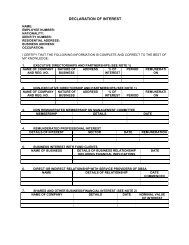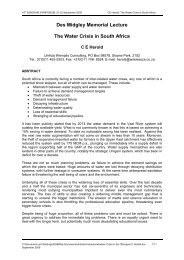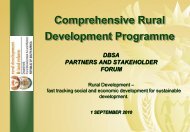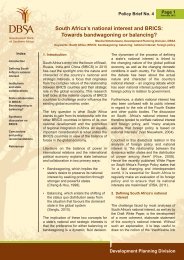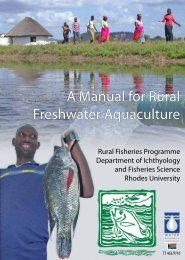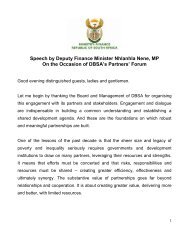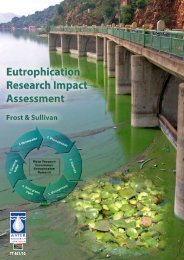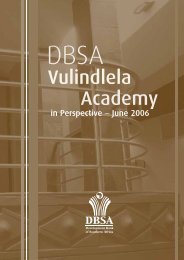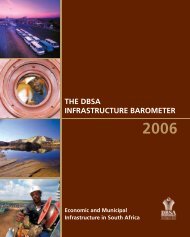WIN-SA 19 Lessons series - Buffalo City
WIN-SA 19 Lessons series - Buffalo City
WIN-SA 19 Lessons series - Buffalo City
Create successful ePaper yourself
Turn your PDF publications into a flip-book with our unique Google optimized e-Paper software.
March<br />
2009<br />
<strong>19</strong><br />
GETTING WATER ASSET<br />
MANAGEMENT RIGHT IN<br />
BUFFALO CITY
OVERVIEW<br />
Water and sanitation infrastructure is one of the most expensive<br />
assets that a municipality owns. Properly designed and well<br />
managed water and sanitation infrastructure supports social and<br />
economic stability, and has good environmental benefits such as the<br />
prevention of leakages, flooding and wastewater pollution. It is for<br />
these reasons that the Municipal Finance Management Act (MFMA)<br />
(Act 56 of 2003) requires municipalities to maintain and safeguard<br />
assets.<br />
There are many negative impacts associated with poor asset<br />
management, the greatest of which is asset failure. Where assets<br />
fail, people are at risk of sickness, and even death. The<br />
environment is also at risk of pollution, and this has a negative<br />
impact on the economic growth. Repairs and replacement of<br />
assets are costly, and negatively impact on municipal budgets<br />
since failure cannot be predicted. While maintenance of assets<br />
involves making provision for ongoing costs, this is on a planned<br />
basis, and tends to limit failure and unpredicted expenditure.<br />
Mr Graham Cowley, General Manager:<br />
Water, Waste Water and Scientific Services,<br />
<strong>Buffalo</strong> <strong>City</strong> Municipality.<br />
2<br />
It is essential that local government councillors and officials<br />
understand the basic issues pertaining to effective asset<br />
management. <strong>WIN</strong>-<strong>SA</strong>, in its mandate to promote knowledge and<br />
information sharing on water and sanitation services delivery,<br />
interviewed the General Manager: Water, Waste Water and<br />
Scientific Services of the <strong>Buffalo</strong> <strong>City</strong> Municipality, Mr Graham<br />
Cowley. The aim was to document the experiences of <strong>Buffalo</strong> <strong>City</strong><br />
Municipality in asset management for wider dissemination and<br />
sharing with municipalities and other water sector partners.<br />
THE MUNICIPALITY<br />
<strong>Buffalo</strong> <strong>City</strong>, located in the Eastern Cape, grew out of four<br />
Transitional Local Councils (TLCs) in 2000. Each of these<br />
entities were previously water services providers in their own<br />
right. At the time of amalgamation Amatola Water and the<br />
Department of Water Affairs and Forestry (DWAF) were<br />
responsible for providing bulk water services in the TLCs. The East<br />
London TLC provided water to East London, Beacon Bay and<br />
Gonubie from its Umzoniana Water Treatment Works. The King<br />
William's Town TLC obtained water from Maden Dam, treated at its<br />
own Water Treatment Works. It supplemented raw water from the<br />
Rooikrantz Dam, and potable water from the Laing Dam, which were<br />
under the control of DWAF. <strong>Buffalo</strong> <strong>City</strong> has incorporated most of the<br />
water and sanitation installations located in the ex-TLC areas. The<br />
Municipality currently includes large urban industrial areas, small<br />
towns, scattered rural settlements and commercial farms.<br />
3<br />
3.1 History of water services provision<br />
BACKGROUND<br />
Prior to the establishment of <strong>Buffalo</strong> <strong>City</strong>, the four TLCs responsible for water services provision used<br />
a manual system for provisioning and asset management. As a newly established trading service<br />
<strong>Buffalo</strong> <strong>City</strong> assumed responsibility for water and sanitation in all four areas. As a result it became
the custodian of records, data and systems in various fragmented forms that were<br />
geographically dispersed and, in many instances, non-operable. Standards differed,<br />
asset information was limited, and work practices and costing varied considerably.<br />
Planned maintenance was limited and more reactive than planned. One of the<br />
consequences of this was that management and decision making was reliant on the<br />
experience of operators rather than being factually informed.<br />
These manual systems may have been effective in the smaller supply areas, but it was not<br />
feasible to continue under the consolidated <strong>Buffalo</strong> <strong>City</strong> Municipality. In the early stages<br />
difficulties were experienced in combining towns and rural areas due to the lack of uniformity<br />
in standards, availability of information on assets and the levels and types of service being<br />
provided.<br />
Hence a more efficient system was necessary to:<br />
Integrate the four supply areas.<br />
Incorporate the associated assets and staff.<br />
Operate and maintain effective water and sanitation services provision throughout the new<br />
supply area.<br />
3.2 The vision<br />
A long term vision for efficient water provision was developed among a dedicated management team in<br />
<strong>Buffalo</strong> <strong>City</strong>. This vision, allied to a 'twinning' relationship with Gävle Kommun, a municipality in Sweden,<br />
led to political, technical and financial support for the establishment of a Water Management Information<br />
System (WMIS) in <strong>Buffalo</strong> <strong>City</strong>. A funding application to the value of R1.5 million was submitted to and<br />
approved by SIDA donor agency in 2003. This allowed for an investigation into the software systems<br />
available on the market, and the appointment of an appropriate service provider. The aim was for the service<br />
provider to work closely with officials in the development of an appropriate system to achieve effective asset<br />
management in <strong>Buffalo</strong> <strong>City</strong>.<br />
3.3 Objective<br />
The main objective was to implement a centrally based and controlled WMIS. This was undertaken with the<br />
view to managing data collection and capturing, and to store that data on a centrally based electronic system.<br />
Furthermore, the stored data had to be converted into usable information in a variety of formats to<br />
enable and inform:<br />
Management of all activities in the Water, Waste Water and Scientific Services Division.<br />
The introduction of effective and sustainable asset maintenance.<br />
Forward planning for provision of sustainable water services.<br />
Management and reduction of non-revenue water.<br />
Production of accurate and informed reports at various levels of management.<br />
Provision of accurate information for development of Master Plans, the water services development<br />
plan (WSDP), and pertinent sections of the integrated development plan (IDP).<br />
3.4 Challenges<br />
Mr Cowley and his team identified a number of challenges to asset management and water services<br />
provision which included:<br />
Human resources and training<br />
Amalgamating previously separate municipal entities involved the inclusion of personnel from a wide<br />
range of backgrounds. These staff had to adapt to new operational systems as the WMIS evolved.<br />
This has included training in the use of the automated job card system, stores, management<br />
information etc. Continual training on asset maintenance forms an integral part of capacity building<br />
in <strong>Buffalo</strong> <strong>City</strong>.
Historical records and systems<br />
Locating and recording type and condition of assets in the<br />
amalgamation process have proven to be major and ongoing<br />
challenges which can only be achieved over an extended period of time<br />
due to poor records and loss of historical memory of systems.<br />
Amalgamation of outdated management systems was a challenge .<br />
Understanding and acceptance of change<br />
Creating awareness among councillors and managers about the value<br />
and importance of transforming water services management from a<br />
manual to an automated system.<br />
Funding<br />
Securing the necessary funding to set up the WMIS and to operate and maintain<br />
the system in an environment where little was known about integrated<br />
management systems.<br />
Drive and commitment<br />
Establishing a committed core management team<br />
within the Municipality to drive the transformation<br />
process.<br />
Appropriate IT support<br />
Selecting asset management software packages<br />
best suited to local conditions and procuring an<br />
appropriate information technology (IT) service<br />
provider with knowledge of water and sanitation<br />
services provision.<br />
Strategic phased approach<br />
4<br />
Delivery problems the WMIS seeks to address<br />
Avoiding the temptation to tackle all aspects of the<br />
WMIS simultaneously and rather pursue a strategic<br />
approach involving the progressive development of<br />
different aspects of the system.<br />
ACHIEVING EFFECTIVE ASSET MANAGEMENT<br />
4.1 The role of asset management in water services provision<br />
Mr Cowley outlined the need for a uniform system of asset management within the Municipality. This need<br />
was identified by managers in the water sector. This was required to enable the Municipality to achieve<br />
MFMA compliance and the creation of a full maintenance plan. “To move away from the old manual paper<br />
based system required political and financial support in Municipal structures,” reported Mr Cowley. This<br />
was achieved by initiating a programme of communications among councillors, and was undertaken by<br />
key staff with a vision for the future of water services provision in the Municipality.<br />
4.2 Overview of the Water Management Information System<br />
An IT service provider was engaged to develop the comprehensive WMIS to support appropriate<br />
operation and maintenance of assets. It was recognized at the outset that it would be a slow process
involving the inclusion of assets from all previous supply areas into one database. Once<br />
complete, the database would form the basis of the Municipal Information Management<br />
System.<br />
Treatment plants, water, sanitation and meter assets were the first components of the new<br />
system included in the database. A number of other components (stores, water quality,<br />
remote sensing etc) have been added progressively to the system since it was initially<br />
developed. This has resulted in the development and use by <strong>Buffalo</strong> <strong>City</strong> of a comprehensive<br />
water asset and project management system.<br />
Inclusion of assets into the database is an ongoing process as each new area is added to the<br />
system. The operational aspects of the system are job card 'driven' with details being recorded<br />
in 'tick boxes' on each electronic job card. These are completed on computer by Foremen at the<br />
end of each job. Job cards include location, time taken to complete the job, staff involved and<br />
materials used. The system incorporates stock located in the stores and stock prices. This is also<br />
known as 'Storeman' as an abbreviation for store management. This allows for activity based<br />
costing, per job, to take place as each job card is completed. Where components on a job have to be<br />
repaired or manufactured (e.g. pump repairs) then the workshop staff are involved and their time,<br />
materials and costs have to be included on the job cards.<br />
Mr Shaun Kumm, who is responsible for plant management (abbreviation is 'Plantman') in <strong>Buffalo</strong> <strong>City</strong>,<br />
says that effective plant maintenance is dependent upon establishing an up to date asset register,<br />
maintenance schedule and the use of telemetry to monitor assets. Telemetry involves reading of meters<br />
and other measuring instruments on bulk infrastructure using remote sensing equipment.<br />
As noted above, maintenance is undertaken through electronic job cards. These are completed at the<br />
workshops or by service providers, depending on where the maintenance is undertaken.<br />
Telemetry is interfaced with 'Plantman' (the plant management system). This allows an ongoing check up on<br />
maintenance scheduling every 30 days. 'Storeman' is linked to 'Plantman' and job cards. The aim is to enable<br />
Millwrights in the workshops, and service providers (where outsourced) to include materials and spares on job<br />
cards for activity based costing purposes. Once each maintenance job is completed it is recorded on the job<br />
card and set aside from active job cards in the 'Plantman' system. These records are then used to create<br />
reports for monitoring of maintenance and formulate future programmes and budgets. Reports can be<br />
prepared in a variety of formats depending upon requirements by management.<br />
Inclusion of stores into WMIS allows for tracking the movement of materials through stores. It also allows for an<br />
automatic stock take. This, in turn, enables the ordering of critical spares which are not normally available at<br />
commercial outlets (e.g. pump impellors, pressure valves, seals etc).<br />
Stores<br />
Workshop repairs<br />
The last major element of WMIS is meters. Mr Mario Loxton, from the <strong>Buffalo</strong> <strong>City</strong> meters section,<br />
indicated that meters form a critical part of assets in water and sanitation services provision. They
are important for cost recovery and for monitoring purposes. Meters<br />
have a life expectancy after which they need to be replaced to ensure<br />
accuracy of readings. Workshops in each of the three District depots<br />
have test rigs and test batches of meters in different supply areas<br />
depending upon age. Where faulty, they are included in the meter<br />
replacement programme.<br />
Monitoring of bulk meters (water) on reservoirs and flow meters (sewer)<br />
on bulk pipelines is undertaken through telemetry. In comparison, small<br />
meter reading on domestic and commercial properties is undertaken by<br />
meter readers in the Treasury division of the Municipality using hand held<br />
devices.<br />
4.3 Additional elements of WMIS<br />
Capacity transfer<br />
A key consideration in the commissioning of WMIS was the capacitation of staff.<br />
This was essential to enable them to operate the system as it evolved. In the<br />
establishment of <strong>Buffalo</strong> <strong>City</strong>, water and sanitation staff were transferred from the ex-<br />
TLCs, Amatola Water and DWAF. The staff were all familiar with the manual job card<br />
systems, and thus required training to enable them to use the automated system.<br />
Similarly, management in water and sanitation services provision required training to<br />
enable them to use the system to monitor performance, costs, turn around times and adjust<br />
management systems accordingly. Stores were also included into the WMIS in the three<br />
District depots in the Municipality. Stores staff in all depots required training to enable them to<br />
record and manage stock on a digital basis through the 'Storeman' system.<br />
Customer care<br />
<strong>Buffalo</strong> <strong>City</strong> is divided into three Districts for water and sanitation services provision, and each<br />
District has its own Manager. The Districts all have Service Request Centres which operate during<br />
working hours. The Fire Department takes responsibility for the after hours customer care function.<br />
One of the improvements being considered in <strong>Buffalo</strong> <strong>City</strong> is the establishment of a 24 hour call centre<br />
for water and sanitation at its Chiselhurst (Coastal District) Depot to service all three Districts after<br />
hours.<br />
Service Request Centre staff work closely with repair teams on a fully automated system where assets are<br />
all geo-referenced (meaning that they can be located spatially by staff on a map). Each complaint is<br />
allocated a unique number which allows for progress tracking. Foremen use map books produced on the<br />
Geographical Information System (GIS) by the GIS Section to locate and geo-reference assets. Linking the<br />
call centres into the WMIS network has allowed for improved turn around times on the repairs and<br />
maintenance of assets. Illustrative performance measures in water services provision have been developed<br />
at <strong>Buffalo</strong> <strong>City</strong> as a basis for performance benchmarking.<br />
Call Centre
Mapping of assets<br />
The locations of all plant, pipe segments and associated network items are captured on<br />
the WMIS mapping system (ARCINFO). The location of each maintenance occurrence is<br />
recorded on job cards and captured in the system. This allows for the establishment of<br />
burst patterns in the water networks and blockages in the sewer networks. This in turn<br />
informs age and condition of pipelines, and feeds into replacement programmes and<br />
Municipal budgets.<br />
Performance Measure<br />
Emergency break<br />
Minor leak<br />
Written complaint<br />
Notification of planned shutdown<br />
Availability of service<br />
Maximum duration of disruption<br />
Unaccounted for water<br />
30 min - 2 hours<br />
1 day - 3 days<br />
5 days - 10 days<br />
4 hours - 24 hours<br />
99.5% - 99.9%<br />
4 hours - 8 hours<br />
10% - 20%<br />
In future the mapping system will be digitally linked with job cards and hand held digital devices to enable<br />
teams to locate assets off the database, and input information directly into the system.<br />
A further application of the mapping system is that it allows for the tracking of capital investment programmes in<br />
capital roll out. This applies both in backlog eradication and in asset replacement programmes.<br />
Financing asset management<br />
The start-up funding for WMIS was provided by the SIDA donor agency amounting to R1.5 million. This was<br />
followed by R6.8 million capital contribution by <strong>Buffalo</strong> <strong>City</strong>, with an annual operating and maintenance budget<br />
of R1.5 million which is serviced by the Municipality. Accessing this funding was premised on mobilizing<br />
internal political and management support for the project. This, allied to a twinning relationship with Gävle<br />
Kommun in Sweden gave rise to both external donor support and the internal budgeting of funding for the<br />
project.<br />
Forward Planning<br />
The WMIS suite was designed to incorporate future infrastructure requirements at two levels. The first<br />
involves making provision for demands for infrastructure associated with new capital developments in the<br />
Municipal area. This is achieved through interfacing with Development Planning in the Municipality on the<br />
basis of a review of the IDP and associated sector plans. The second provision in WMIS is planning for<br />
asset renewal. This forms an integral part of WMIS where an asset requiring replacement towards the<br />
end of its normal lifespan is included in the budgeting process.<br />
LESSONS 5<br />
5.1 Key <strong>Lessons</strong><br />
The key lessons emerging from <strong>Buffalo</strong> <strong>City</strong>'s asset management experience include:<br />
Asset management forms an integral part of the wider services provisioning function, and
cannot be dealt with as a stand alone function. This has been<br />
undertaken through the WMIS in <strong>Buffalo</strong> <strong>City</strong>.<br />
The quality of water and sanitation services provision is closely tied<br />
up with and dependent on effective asset management in a supply<br />
area.<br />
Recognition of the importance of political commitment to<br />
transformation of outdated asset management and services<br />
provisioning systems by councillors and managers is critical to<br />
realizing visions for change. Political commitment is essential to<br />
instituting effective asset management in municipalities.<br />
Major value can be added through twinning programmes where councillors,<br />
managers and technical staff are able to see the benefits of migrating to a<br />
new, more comprehensive management system<br />
The importance of a dedicated core team prepared to work constantly at change<br />
management and improving the quality of water and sanitation services provision<br />
inclusive of asset management is essential to the success of such initiatives.<br />
Preparedness of staff to undergo significant initial and continuing 'hands on' training is<br />
an important pre-condition to enable them to effectively operate and 'grow' in the new<br />
systems as they evolve.<br />
Making provision for the advancement of exceptional staff and staff who have consistently<br />
performed well in the new environment is a critical success factor.<br />
Ensuring appointment of the correct IT service provider to develop and adapt the WMIS system<br />
was critical in achieving the final outcome.<br />
Implementation of an effective WMIS should follow a phased approach inclusive of the following key<br />
elements:<br />
Communications<br />
Hardware and network establishment<br />
Software and basic training of staff<br />
Implementation of management software<br />
Establishment of a comprehensive customer care system<br />
Automation of job cards and training of staff in use of the system<br />
Effective management<br />
Ongoing development and maintenance of the system<br />
Costs and financing mechanisms.<br />
5.2 Support for Municipalities<br />
Mr Cowley has indicated that the team in <strong>Buffalo</strong> <strong>City</strong> would be prepared to provide support to other<br />
municipalities wishing to establish an integrated water and sanitation management system. He is of the view<br />
that other municipalities wishing to embark on this 'road' could potentially be 'up and running' in a shorter period<br />
of time than Buffaclo <strong>City</strong>, dependent upon size and complexity of the water sector in these municipalities.<br />
Mr Cowley notes that, “Owing to the success that <strong>Buffalo</strong> <strong>City</strong> has experienced in integrated water<br />
management, our Electricity Department has decided to convert to this system in order to provide a more<br />
cost efficient service to the consumers of the Municipality.”
FOR MORE INFORMATION CONTACT 6<br />
Mr Graham Cowley, General Manager: Water, Waste Water and Scientific Services, <strong>Buffalo</strong><br />
<strong>City</strong> Municipality (emai l: grahamc@buffalocity.gov.za / phone 043 705 2084)<br />
ACKNOWLEDGEMENTS 7<br />
Mr Graham Cowley (General Manager: Water, Waste Water and Scientific Services), Mr Mark<br />
Westerberg (Manager: Sanitation Services) and Mr Shaun Kumm (Area Manager) of the <strong>Buffalo</strong><br />
<strong>City</strong> Municipality are acknowledged for the time spent and information made available during the<br />
course of the interview.<br />
REFRENCES 8<br />
From Data to Information – Bridging the Gap, IME<strong>SA</strong> Presentation, Cowley G and Leonie A (2008)<br />
Border Chamber of Business Presentation, Cowley G (2008)<br />
Operation and Maintenance Challenges, WI<strong>SA</strong> Presentation, Westerberg M (2007)
N<br />
FOR YOUR NOTES
FOR YOUR NOTES<br />
N
The <strong>WIN</strong>-<strong>SA</strong> lessons <strong>series</strong> aims to capture the innovative work of people tackling real<br />
service delivery challenges. It also aims to stimulate learning and sharing around<br />
these challenges to support creative solutions. To achieve this, the lessons <strong>series</strong> is<br />
supported by ancillary learning opportunities facilitated by <strong>WIN</strong>-<strong>SA</strong> to strengthen<br />
people-to-people learning.<br />
<strong>WIN</strong>-<strong>SA</strong> mission<br />
To find out more about these and other <strong>WIN</strong>-<strong>SA</strong> services go to the <strong>WIN</strong>-<strong>SA</strong> portal at<br />
www.win-sa.org.za or contact the Network directly.<br />
This document hopes to encourage ongoing discussion, debate and lesson sharing.<br />
To comment, make additions or give further input, please visit<br />
www.win-sa.org.za or send an email to info@win-sa.org.za.<br />
Our mission is to ensure the body of knowledge in the<br />
sector is well managed, readily accessible and applied,<br />
leading to improved decision-making and performance,<br />
especially of local government.<br />
Address: 491 18th Avenue, Rietfontein, Pretoria<br />
Postal Address: Private Bag X03, Gezina, 0031<br />
Tel: (012) 330 9076 Fax: (012) 331 2565<br />
E-mail: info@win-sa.org.za<br />
Website: www.win-sa.org.za



